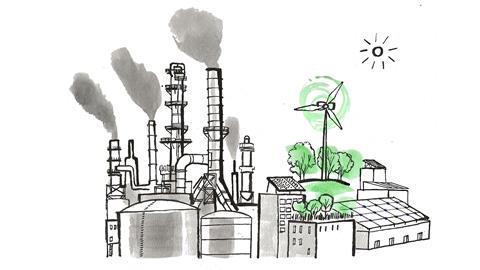Efforts to reduce the environmental impact of chemical processes have shaped the evolution of the entire sector
In the past 20 years, the importance of sustainability in the chemical industry has risen dramatically. Back in 2004, there was far less recognition of where raw materials come from, the resources consumed and discharged as products are made and used, and what happens to products at end-of-life. But nowadays, a significant focus on sustainability is almost essential to operating in the chemicals sector.

Some companies were already starting to take the concept seriously, though, including BASF. Peter Saling joined the company as a researcher in the dyestuffs laboratory in the early 1990s, and was part of a small group that developed eco-efficiency analysis methodology. He is now the company’s director of sustainability activities.
‘There was a lot of potential, as the first standards for lifecycle analysis were just appearing, and we came up with new ideas,’ he says. ‘We wanted to show the position of chemistry in different sectors, helping us to have a modern life but with reduced environmental impacts, and also take costs into consideration. We started with very simple models, but the ideas were good.’
Internal discussions were not always easy, he says, because people asked why it was needed. But, with the backing of chief executive Jürgen Strube, the concept was pushed forward and extended beyond merely eco-efficiency, and BASF became one of the first companies to publish a corporate carbon footprint in the early 2000s.
Another big German chemicals business, Covestro, also got into the game early with chief executive support, according to Christian Haessler, who is now its global head of public affairs after serving in numerous roles at Covestro and Bayer over the years, including head of sustainability. He explains that former Covestro chief Patrick Thomas, who was also chief executive of Bayer MaterialScience ahead of its spin-off in 2016, had pushed a vision of ‘People, Planet, Profit’, a decade before Covestro’s formation.
‘This was long before regulations kicked in, and the CO2 discussion began – it was far-sighted from him, and also a motivation for the company,’ Haessler says. ‘Now, people are clear about its importance. A lot of individuals are personally connected to sustainability, and if you put it forward as a company, you have inherently motivated your staff. Now, everybody is behind the circular economy.’

Julia Rowe has also been engaged in sustainability topics for many years, witnessing its progression over that time. Back in 2004, as a development chemist at Johnson Matthey (she recently left the company, where she was most recently global sustainability director), she says she rarely gave any thought to where the raw materials came from, or whether they could be recycled. As an expert panel member for the Faraday Institution’s lithium-ion battery recycling research project, she is clear about the importance of careful sourcing and recycling of metals.
‘Metals like cobalt are often mined in the Democratic Republic of Congo, or the high Andes, or Russia, where the geopolitical aspects are important,’ she says. ‘And then there’s scarcity. How many times has something been invented, but we can’t make it as we don’t think there are enough raw materials? Iridium is an obvious example at the moment with the hydrogen industry. Chemists in the lab now will be thinking about that.’
Reducing energy
In the early days, Haessler says, there was a tendency to address topics where cost savings and sustainability came together. ‘Energy savings are a good example,’ he says. ‘The more difficult ones now are those that need investments that cost money, and there has to be a value chain that absorbs the costs with you.’
Biomass, CO2 and waste are the three sources that will take over from fossil materials in the coming decades
Rowe says the recent energy crisis has sharpened the focus on energy usage. ‘Suddenly making something in a less energy intensive way seems like a good idea for climate change, for energy security and for cost,’ Rowe says. ‘When gas was cheap, there was less of a driver. Renewable electricity is, obviously, even cleaner, but the cost angle remains.’
Another pillar of sustainability is the desire to move away from petroleum-based raw materials. ‘Biomass, CO2 and waste are the three sources that will take over from fossil materials in the coming decades,’ Haessler says. ‘Most studies now assume the majority will be waste, to help solve the plastic waste problem, with bio and CO2 a bit lower at maybe 20 or 30% each. Then the second pillar, besides the raw materials, is to make our products recyclable.’
Recycling resources
Haessler cites the example of Covestro’s recycled polycarbonates. ‘Mechanical recycling has been around for some time, and our portfolio includes product lines that contain recycled material,’ he says. ‘Demand was quite sluggish for many years because it is more expensive, and the performance is inferior to virgin material. But now, with the sustainability pressure to reduce the CO2 footprint and have a recycling quota, and in a society that will pay more for sustainability, the demand for this material is now rising sharply.’
Regulation and legislation are now significant drivers of recycling requirements, such as the introduction of recycling minimum standards by the EU, for example. ‘Now “design for recycle” is becoming something you simply have to do,’ Rowe says.
And complexity is also an issue, as even where there are recycling rules, logistically it can be difficult. ‘Will the chemical industry simplify the number of plastics it makes if it has to upcycle, or downcycle to reuse the basic monomers?’ Rowe says. ‘There is too much complexity at the moment. The idea that you can break down a plastic to its original monomer and then remake it is very attractive if you want to be more sustainable. But the complexity lies in sorting the plastics, and this is a big challenge for industry – designing a recycling process when designing a product which we would never thought of 20 years ago.’
This is going to be essential, particularly for products like phones that currently can’t readily be taken apart. ‘One driver is to recover the precious metals – there is half the periodic table in a phone!’ she says. ‘This has to change, because we will run out of metals like cobalt if we don’t recycle.’
Reliable reporting
The public now expects companies to tell them what they’re doing. ‘We publish our studies, and work with external third parties who review them,’ Saling says. ‘The expertise and the datasets are growing, and it’s not just for “odd” people as it was 30 years ago. It’s now a big endeavour. My team and I have prepared 700 [lifecycle analyses] or eco-efficiency studies over the years.’
Even 20 years ago, Saling says, they were confident they could show what chemistry could achieve. ‘While making a product might emit 1kg of CO2, with our materials 3kg could be saved,’ he says. ‘This was lifecycle thinking, which is increasingly important today – looking beyond our own boundaries, upwards at what our suppliers are doing, and down at what our customers are doing. And what does end-of-life recycling look like? That’s the beauty of a lifecycle assessment – you can really see the impacts along the whole supply chain, and where improvements could be made. And we also started to compare with our competitors, and competing technologies.’
Robust regulation required
The level of detail that’s expected is growing, too. ‘When we made a carbon footprint 20 years ago, people wanted to know if it was 1kg, 5kg or 20kg of carbon,’ Saling says. ‘Today, they ask, is it 5.3kg or 5.4kg? This shows the level of interest and the requirement of quality of results there now is in the topic.’
There is also a growing recognition that these data need to be used to inform decisions. ‘Sustainability should cover the whole picture, including the early phases of R&D,’ Saling says. ‘And at the end, we have a full picture for making investment decisions, including taking a future-oriented view. It might suggest that the product is not a good idea, but equally it might say it’s great.’
It will involve a lot of money and effort. But we simply have to do it, and industry will have to work together
A few years ago, Saling’s team made a retrospective review of some of its analyses, looking at its original recommendation and how the market has developed. ‘Our recommendation turned out to be correct most of the time,’ he says. ‘It has made us confident to say that if we do something in a certain way there is a lot of potential to drive BASF to being a more sustainable company, and to support R&D and marketing strategies.’
If sustainability metrics are not carefully monitored, there is a risk that the entire exercise will face accusations of greenwashing. It is important to have good analysis, good reporting, and third-party verification, if you want to report results to the public. ‘It is always important to look at the whole picture,’ Saling says. ‘For example, you need energy to produce insulation materials, but this can be recouped typically in nine months. People need the facts, and we need to transfer these facts in an easy-to-understand way to broader societies.’
Crucial cooperation
The drive to emission reduction, unsurprisingly, started with Scope 1 and 2 emissions (from companies’ direct operations and energy purchase and generation), which are relatively straightforward and controllable. Scope 3 emissions (indirect emissions from activities upstream and downstream in value chains) are much more challenging to address, but critical for sustainability. ‘Scope 3 requires investments, enough green energy, and involves the whole value chain,’ Haessler says. ‘If a company wants to be climate neutral, it has to be addressed with targets now, but for affordability we are dependent on finding value chains that will absorb the cost together with us. We cannot invest alone and then have the same market prices for more expensive raw materials – this makes no sense for industry.’
As sustainability targets evolve, there is now a drive for companies to reach net zero by 2050, if not sooner. Saling believes there is a good chance this will be achieved but, he says, it won’t be easy. ‘But we have to do it, for our children and their children,’ he says. ‘It is a key element of sustainability. It will involve a lot of money and effort. But we simply have to do it, and industry will have to work together if we are going to get there.’
Haessler remains optimistic. ‘I was working in solar 30 years ago, when it was tiny, and while they were real green enthusiasts, they definitely did not expect that 15–20% of today’s energy supply, at least in Germany, would be from solar now,’ he says. ‘It shows that transformations are possible, but of course the circular economy is much more complicated than introducing a new technology like solar. If politics, the financial sector, industry and society all move in the same direction, it will work. Of course there is the debate about what the costs are, who pays, and how to do it, but the sustainability direction is set, and I am optimistic that this transformation will happen. The question is, of course, about speed, and exactly how it will be done.’


















No comments yet